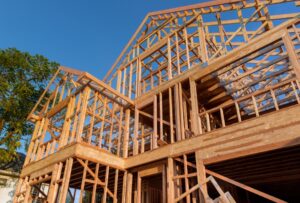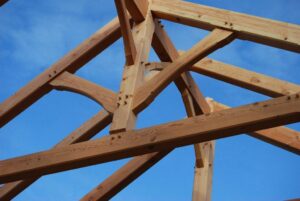Stick Framing vs. Timber Framing: Understanding the Difference and the Benefits of Going Timber
When it comes to building a home or structure, the framing method plays a crucial role in both aesthetics and performance. Two of the most common framing methods are stick framing and timber framing. While stick framing has become the standard in modern residential construction, timber framing is making a comeback thanks to its durability, beauty, and eco-friendliness. Here’s a breakdown of the key differences between the two methods—and why more builders and homeowners are choosing timber.
What Is Stick Framing?
Stick framing, also known as conventional framing, is the process of building a structure one board at a time using dimensional lumber (like 2x4s and 2x6s). It’s the most common method used in the U.S. for residential construction.
Key Features of Stick Framing:

-
Uses standardized lumber and fasteners (nails, screws, metal brackets)
-
Constructed on-site, piece by piece
-
Relies on sheathing, drywall, and siding for structural stability
-
Typically insulated with fiberglass or spray foam
Pros:
-
Fast and cost-effective
-
Materials are widely available
-
Well-suited for modern building codes and utility installation
Cons:
-
Shorter lifespan due to vulnerability to moisture, pests, and warping
-
Less visually appealing without decorative treatments
-
Less energy-efficient unless additional steps are taken
What Is Timber Framing?
Timber framing is a traditional construction method that uses large wooden beams connected by mortise-and-tenon joinery, secured with wooden pegs. It dates back thousands of years and has stood the test of time—many timber-framed structures from the Middle Ages are still standing today.
Key Features of Timber Framing:

-
Built with large, solid wood timbers (often hand-hewn or milled)
-
Joinery is often visible and part of the architectural style
-
Can be prefabricated off-site and assembled quickly on location
-
Allows for open-concept designs with fewer interior load-bearing walls
Benefits of Timber Framing
1. Durability and Longevity
Timber frame buildings are known for their strength and durability. Properly maintained, they can last for centuries. The massive timbers are resistant to sagging and twisting over time.
2. Aesthetic Appeal
One of the most noticeable differences is in appearance. Exposed beams and beautiful wood joinery create a timeless, rustic elegance that’s hard to replicate with stick framing.
3. Sustainability
Timber framing uses fewer materials overall and can utilize sustainably harvested wood. Many builders also use reclaimed timbers, reducing the environmental impact further.
4. Energy Efficiency
The design of timber frame homes often allows for structural insulated panels (SIPs) or other high-performance wall systems, leading to excellent thermal insulation and energy savings.
5. Open Interior Spaces
Because of the strength of the timber frame, interior walls are often unnecessary for structural support. This gives homeowners more flexibility in design and layout, including soaring ceilings and open-concept living.
6. Craftsmanship
Timber framing is as much an art as it is a building method. The joinery, carving, and attention to detail reflect high levels of craftsmanship, often becoming a talking point or centerpiece of the home.
Which Should You Choose?
If you’re looking for quick, low-cost construction for a standard home, stick framing might be the way to go. But if you’re after something truly special—something that blends beauty, strength, and sustainability—timber framing is hard to beat.
Whether you’re building a home, a barn, or even a commercial structure, timber framing offers a timeless alternative with benefits that last generations.
Interested in getting a free quote for your project? Timbercraft offers free proposals to give you an idea of what to expect when it comes to timber frame builds. Feel free to contact us for your free proposal email at [email protected] or call 734-864-9790
